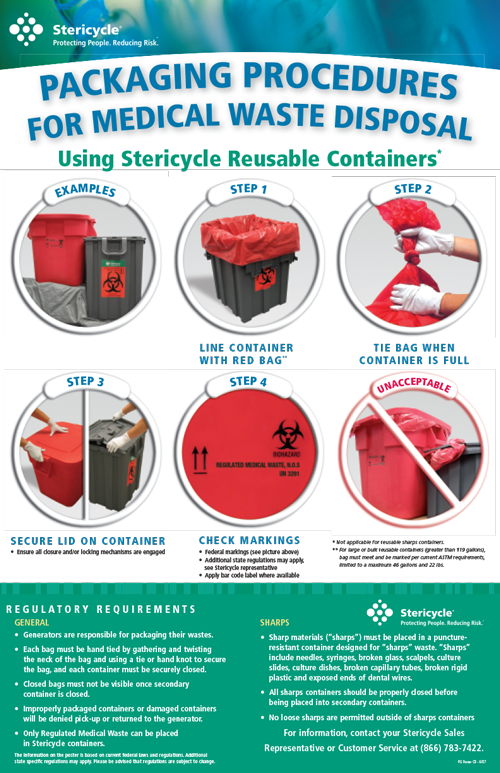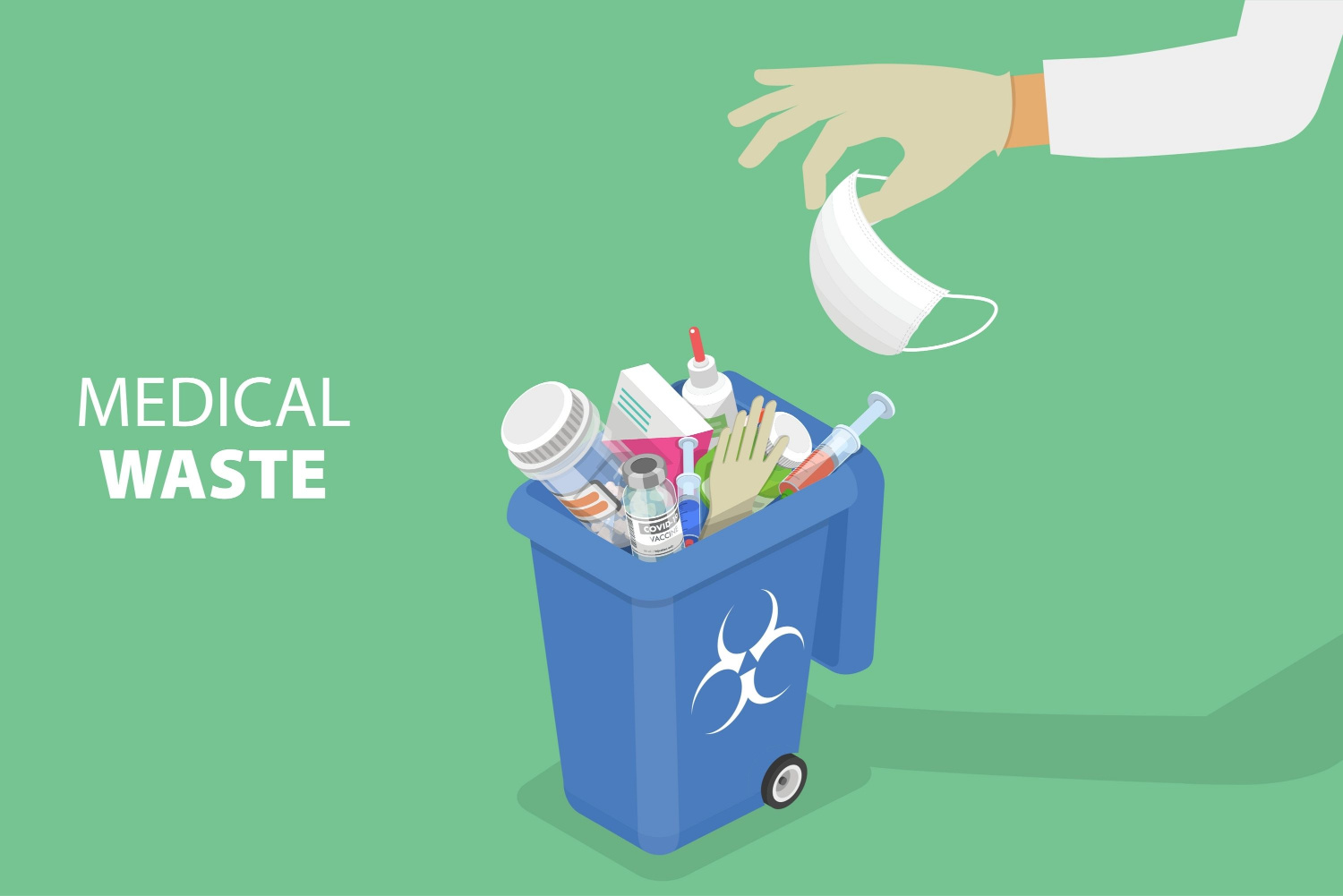Compliant and Reliable Medical Waste Removal Service: Partnering for a Cleanser Future
Wiki Article
Compliance and Regulations for Medical Garbage Disposal
Compliance and regulations for clinical waste disposal play an essential duty in making sure the safety and security and wellness of both health care professionals and the general public. Proper management of clinical waste is important to protect against the spread of infections, protect the environment, and keep public wellness. These policies include different facets, consisting of the classification and segregation of clinical waste, correct storage space and handling procedures, as well as transportation and disposal methods.Relevance of Compliance
The relevance of conformity with policies for clinical garbage disposal can not be overemphasized. Proper disposal of medical waste is crucial for making sure the security and well-being of health care workers, individuals, and the basic public. Medical waste, which consists of things such as used needles, infected handwear covers, and biomedical waste, can pose severe health and wellness threats if not handled and disposed of correctly.Conformity with laws makes certain that medical waste is taken care of in a way that decreases the potential for exposure to contagious diseases and damaging compounds - medical waste disposal service. It aids protect against the spread of infections, such as HIV, liver disease B and C, and other bloodborne microorganisms. Conformity also plays an essential role in shielding the atmosphere by preventing contamination of water sources, soil, and air
Failure to abide with guidelines can lead to serious consequences for healthcare centers, consisting of penalties, lawful action, and damages to their credibility. Additionally, non-compliance might compromise the health and wellness of health care workers, patients, and the neighborhood.
Conformity with guidelines for clinical waste disposal requires adherence to specific standards and protocols. These might consist of correct segregation, packaging, labeling, and storage of medical waste. It likewise involves using approved disposal techniques, such as incineration, autoclaving, or landfilling, relying on the sort of waste.
Regulatory Agencies and Bodies
Regulatory companies and bodies play an important function in looking after compliance with policies for clinical waste disposal. These organizations are in charge of setting guidelines, procedures, and requirements to make certain the appropriate and secure handling of clinical waste. They implement and keep an eye on compliance to secure public wellness and the setting.One of one of the most prominent regulatory companies in the United States is the Environmental Protection Agency (EPA) The EPA is accountable for regulating the storage, transportation, therapy, and disposal of clinical waste. They develop guidelines for waste generators, transporters, and therapy centers to follow, ensuring that all required preventative measures are taken to avoid the spread of illness and contamination.
An additional important regulative body is the Occupational Safety And Security and Wellness Management (OSHA) OSHA establishes standards and laws to safeguard workers from work risks, consisting of those pertaining to clinical waste. WasteX Medical Waste Disposal. They offer guidelines for the secure handling and disposal of clinical waste to safeguard workers in health care facilities
In addition to these government agencies, individual states likewise have their very own governing bodies that oversee medical garbage disposal. These agencies might have their very own specific laws and demands that have to be complied with.

Classification and Segregation of Clinical Waste
To ensure correct management of clinical waste, it is necessary to classify and segregate it according to established methods and guidelines. medical waste removal service. Classification and segregation play a crucial function in minimizing the danger of infection, securing the environment, and ensuring the safety and security of healthcare employees and the basic publicClinical waste is categorized right into different classifications based upon its possible hazard level. These classifications include transmittable waste, pathological waste, sharps waste, pharmaceutical waste, chemical waste, and contaminated waste. Each group calls for details handling, transport, disposal, and storage techniques to lessen the risk of exposure and contamination.
Partition of clinical waste includes dividing different types of waste at the resource. This process makes certain that waste with various hazard degrees is not combined, decreasing the capacity for cross-contamination and making disposal treatments more efficient. Proper partition is accomplished via making use of color-coded containers and labels, which aid medical care workers and waste administration employees determine and manage each type of waste properly.
Along with classification and segregation, health care centers should likewise follow neighborhood, state, and federal guidelines pertaining to medical waste monitoring. These laws describe specific demands for storage, transport, treatment, and final disposal of clinical waste, guaranteeing conformity and maintaining public wellness and security.
Correct Storage and Managing Procedures
Proper storage space and dealing with procedures play an essential duty in making sure the compliant and risk-free monitoring of medical waste. Clinical waste, which consists of products such as used syringes, infected handwear covers, and ran out medications, can posture severe health and ecological threats if not managed correctly. Consequently, it is vital for healthcare centers and various other generators of clinical waste to carry out rigorous storage space and taking care of procedures.
To start with, medical waste ought to be stored in durable, leak-proof containers that are specifically developed for this purpose. These containers ought to be identified with the universal biohazard icon and words "clinical waste" to plainly show the components. Additionally, the containers ought to be kept firmly near avoid any prospective leak or spillage.
Additionally, it is essential to set apart different sorts of medical waste to avoid cross-contamination. Sharps, such as scalpels and needles, must be kept in puncture-resistant containers to reduce the risk of injuries - WasteX Medical Waste Disposal. Chemical waste, such as disinfectants and solvents, must be stored separately from various other kinds of medical waste to stop chemical responses or unsafe direct exposures

Transport and Disposal Techniques
Health care facilities have to make sure the risk-free transportation and correct disposal of their clinical waste to conform with regulations and shield public wellness. Transportation and disposal methods play a crucial duty in avoiding the spread of infectious conditions and lessening the environmental impact of clinical waste.
To transfer clinical waste, health care facilities need to utilize leak-proof and puncture-resistant containers that are labeled with the biohazard icon. These containers ought to be firmly sealed to avoid any kind of leakage throughout transportation. In addition, health care centers ought to develop procedures for the transport process, consisting of making use of qualified employees and devoted cars.
When the clinical waste reaches the disposal center, it undertakes various approaches of therapy. One typical continue reading this approach is incineration, which involves melting the waste at heats to ruin virus and decrease the quantity of waste. An additional method is autoclaving, which utilizes vapor and pressure to disinfect the waste. After therapy, the waste is generally sent out to a land fill or a waste-to-energy facility for final disposal.
It is necessary for medical care centers to collaborate with licensed and permitted waste management companies to guarantee proper transportation and disposal of medical waste. These business have the expertise and resources to handle medical waste securely and in compliance with regulations.
Conclusion
In verdict, conformity with policies for clinical waste disposal is of utmost value to guarantee public health and safety and security. On the whole, adherence to compliance and regulations is essential to effectively handle medical waste.Medical waste, which consists of items such as made use of needles, contaminated handwear covers, and biomedical waste, can pose severe health dangers if not taken care of and disposed of correctly.
These groups consist of contagious waste, pathological waste, sharps waste, pharmaceutical waste, chemical waste, and radioactive waste.Segregation of clinical waste includes separating different types of waste at the source. Proper segregation is accomplished via the usage of color-coded labels and containers, which help healthcare employees and waste administration employees take care of each kind and determine of waste appropriately.
Chemical waste, such as solvents and anti-bacterials, need to be stored individually from other kinds of clinical waste to protect against harmful direct exposures or chemical responses.
Report this wiki page